AB PHYSICAL-CHEMICAL WASTEWATER TREATMENT PLANT
The American Bottoms PChem Plant is located in the Village of Sauget, Illinois. The plant is a physical-chemical plant which provides preliminary and primary treatment for industries located in the Village of Sauget and operates 24 hours per day, 365 days per year. The plant was originally constructed in 1942 and has had many additions of treatment equipment and processes to the plant over the years. When the American Bottoms plant opened in 1986, the PChem plant began conveying its treated water to American Bottoms for secondary biological activated sludge treatment. The primary goals of the treatment process at PChem are to neutralize the pH, to remove metals, to remove oil, and to prepare the wastewater for secondary treatment at American Bottoms. The PChem plant also contains a hauled wastewater discharge facility where approved hauled wastewater streams can be discharged for treatment.
PChem Preliminary Treatment:
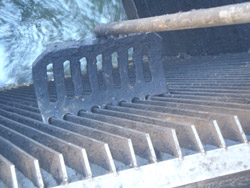 Wastewater flows from the industries and storm drains through a system of pipes to a pump station located at the PChem facility. The PChem plant can process flow rates of 26 million gallons per day through the plant. The process begins with the removal of large trash and debris from the wastestream. Two industrial grade screens, called barscreens, catch the trash and debris consisting of things like cans, bottles, plastic bags, lawn clippings, and all the things you might see in the gutters along the streets. The PChem bar screens are manually raked to pull the debris and trash from the screen into a trough located at the top of the screen. The trash and debris are then shoveled into a hopper and dumped into a dumpster for disposal at a landfill.
Wastewater flows from the industries and storm drains through a system of pipes to a pump station located at the PChem facility. The PChem plant can process flow rates of 26 million gallons per day through the plant. The process begins with the removal of large trash and debris from the wastestream. Two industrial grade screens, called barscreens, catch the trash and debris consisting of things like cans, bottles, plastic bags, lawn clippings, and all the things you might see in the gutters along the streets. The PChem bar screens are manually raked to pull the debris and trash from the screen into a trough located at the top of the screen. The trash and debris are then shoveled into a hopper and dumped into a dumpster for disposal at a landfill.
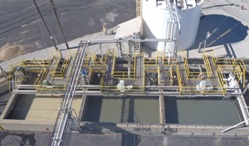
Once the large trash and debris are removed, all floating oil is removed by nine oil skimming units made up of two belt skimmers and seven rope skimmers. The oil is picked up by the skimmers and captured in a day tank. It is then pumped to a storage tank where any excess water picked up with the oil is allowed to separate to be returned back to the process. Once this tank is full, the oil is transferred to a final storage tank where it is tested prior to disposal. After screening and oil removal, the water is conveyed to the neutralization process by pumps.
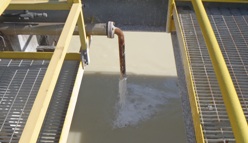 Neutralizing the wastewater ensures that it is no longer corrosive. This protects the equipment further down the treatment process. The addition of lime and the increase of pH will also allow the dissolved metals in the wastewater to precipitate out in the primary treatment process. Neutralization is also required to ensure no upsets occur in the biological process at American Bottoms during secondary treatment.The final stage of the preliminary treatment process is the neutralization process. The waste stream entering the PChem facility typically has a pH less than 3. Due to the extremely low pH of the influent wastewater, large quantities of lime must be added to achieve the optimum pH level of 8.3. An average of 248 dry tons of lime per month is used at the PChem treatment facility. Dry lime is mixed with water in a very reactive process called slaking to form a lime slurry. PChem contains two lime slakers and two lime silos for storing dry lime. The lime slurry is added in a series of three completely mixed tanks to adjust the pH of the incoming wastewater.
Neutralizing the wastewater ensures that it is no longer corrosive. This protects the equipment further down the treatment process. The addition of lime and the increase of pH will also allow the dissolved metals in the wastewater to precipitate out in the primary treatment process. Neutralization is also required to ensure no upsets occur in the biological process at American Bottoms during secondary treatment.The final stage of the preliminary treatment process is the neutralization process. The waste stream entering the PChem facility typically has a pH less than 3. Due to the extremely low pH of the influent wastewater, large quantities of lime must be added to achieve the optimum pH level of 8.3. An average of 248 dry tons of lime per month is used at the PChem treatment facility. Dry lime is mixed with water in a very reactive process called slaking to form a lime slurry. PChem contains two lime slakers and two lime silos for storing dry lime. The lime slurry is added in a series of three completely mixed tanks to adjust the pH of the incoming wastewater.
The wastewater has now completed the various stages of preliminary treatment and is ready for primary treatment at PChem.
PChem Primary Treatment:
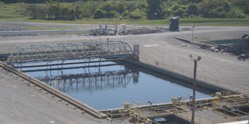 The heavily flocculated water then enters a set of rectangular tanks called clarifiers. The primary purpose of the clarifiers at PChem is to settle out heavy solids, including the metals contained in the wastewater. The wastewater flows into one end and flows out over v-notched weirs at the opposite end. As the water travels across the clarifier, the heavy solids fall to the bottom. A traveling bridge pushes these solids to sludge pits at the end of the clarifiers. Primary treatment at PChem starts by adding a liquid chemical called polymer to the wastewater stream prior to entering the flocculation process. The purpose of the liquid polymer is to aid in the flocculation of the solids in the wastewater. Flocculation is the formation of clumps of solids, or “flocs”, in the wastewater. Once the polymer is added, the water flows into a flocculation chamber which contains three slowly rotating paddle mixers. The mixers slowly mix the wastewater and polymer encouraging the flocs to form.
The heavily flocculated water then enters a set of rectangular tanks called clarifiers. The primary purpose of the clarifiers at PChem is to settle out heavy solids, including the metals contained in the wastewater. The wastewater flows into one end and flows out over v-notched weirs at the opposite end. As the water travels across the clarifier, the heavy solids fall to the bottom. A traveling bridge pushes these solids to sludge pits at the end of the clarifiers. Primary treatment at PChem starts by adding a liquid chemical called polymer to the wastewater stream prior to entering the flocculation process. The purpose of the liquid polymer is to aid in the flocculation of the solids in the wastewater. Flocculation is the formation of clumps of solids, or “flocs”, in the wastewater. Once the polymer is added, the water flows into a flocculation chamber which contains three slowly rotating paddle mixers. The mixers slowly mix the wastewater and polymer encouraging the flocs to form.
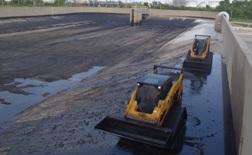 During heavy storms our PChem plant can become overloaded. When this happens, we have a large storage tank called the storm water basin which holds this excess wastewater until the flows return to normal levels. All water stored in the tank is returned back through the plant for treatment.The solids pushed into the sludge pits by the traveling bridge are generally very thick. There is an agitator in each of the pits which is used to gently stir the water and sludge, causing the sludge to fall down the sloped walls and into the sludge pits. The sludge is pumped from the pits to the sludge handling process at PChem.
During heavy storms our PChem plant can become overloaded. When this happens, we have a large storage tank called the storm water basin which holds this excess wastewater until the flows return to normal levels. All water stored in the tank is returned back through the plant for treatment.The solids pushed into the sludge pits by the traveling bridge are generally very thick. There is an agitator in each of the pits which is used to gently stir the water and sludge, causing the sludge to fall down the sloped walls and into the sludge pits. The sludge is pumped from the pits to the sludge handling process at PChem.
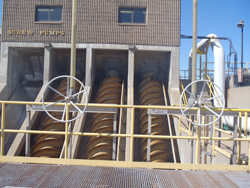 The water flowing over the weirs of the rectangular clarifier pass through a flow measuring device called a parshall flume. The amount of water leaving the plant is measured by this structure. Samples of the effluent water are also taken at this location and monitored by the plant’s certified laboratory to ensure compliance. The plant also has the capability of adding sodium hydrosulfide at this location to combine with any excess metals to prevent an upset in the secondary biological process at American Bottoms. The water leaving the flume structure flows through a 42 inch sewer to the American Bottoms plant for secondary treatment. The water is pumped into the American Bottoms plant by three screw pumps.
The water flowing over the weirs of the rectangular clarifier pass through a flow measuring device called a parshall flume. The amount of water leaving the plant is measured by this structure. Samples of the effluent water are also taken at this location and monitored by the plant’s certified laboratory to ensure compliance. The plant also has the capability of adding sodium hydrosulfide at this location to combine with any excess metals to prevent an upset in the secondary biological process at American Bottoms. The water leaving the flume structure flows through a 42 inch sewer to the American Bottoms plant for secondary treatment. The water is pumped into the American Bottoms plant by three screw pumps.
Sludge Handling:
Sludge is pumped from the clarifier sludge pits to a storage tank. The sludge is then pumped from this tank to a belt filter press at PChem. Polymer is mixed into the sludge as it is being pumped to the press to help the water separate from the solids. The polymer conditioned sludge passes through a single belt filter press where it is squeezed to remove as much water as possible. Pressure is applied as the sludge is squeezed between belts. This pushes water from the sludge. The dewatered sludge, also called filter cake, is removed from the belt with scrapers where it falls to a conveyor and is conveyed directly to a dumpster that is hauled to a landfill.
Hauled Wastewater:
The PChem plant has the capability to accept approved hauled wastewater discharges. Although the plant can’t accept hazardous waste, it can take high or low pH wastewaters, oily wastewaters, metal-bearing wastewaters, and more due to the treatment processes and capabilities of the facility. For more information on the hauled wastewater program, please see the hauled waste section of this web site.
Every one of our employees knows that treating wastewater is our primary responsibility for the protection of our nation’s water resources both today and for future generations. The PChem plant is a critical component for providing beneficial services for our industrial customers in a cost effective manner and for providing a high quality wastewater effluent at the American Bottoms Regional Treatment Facility.
